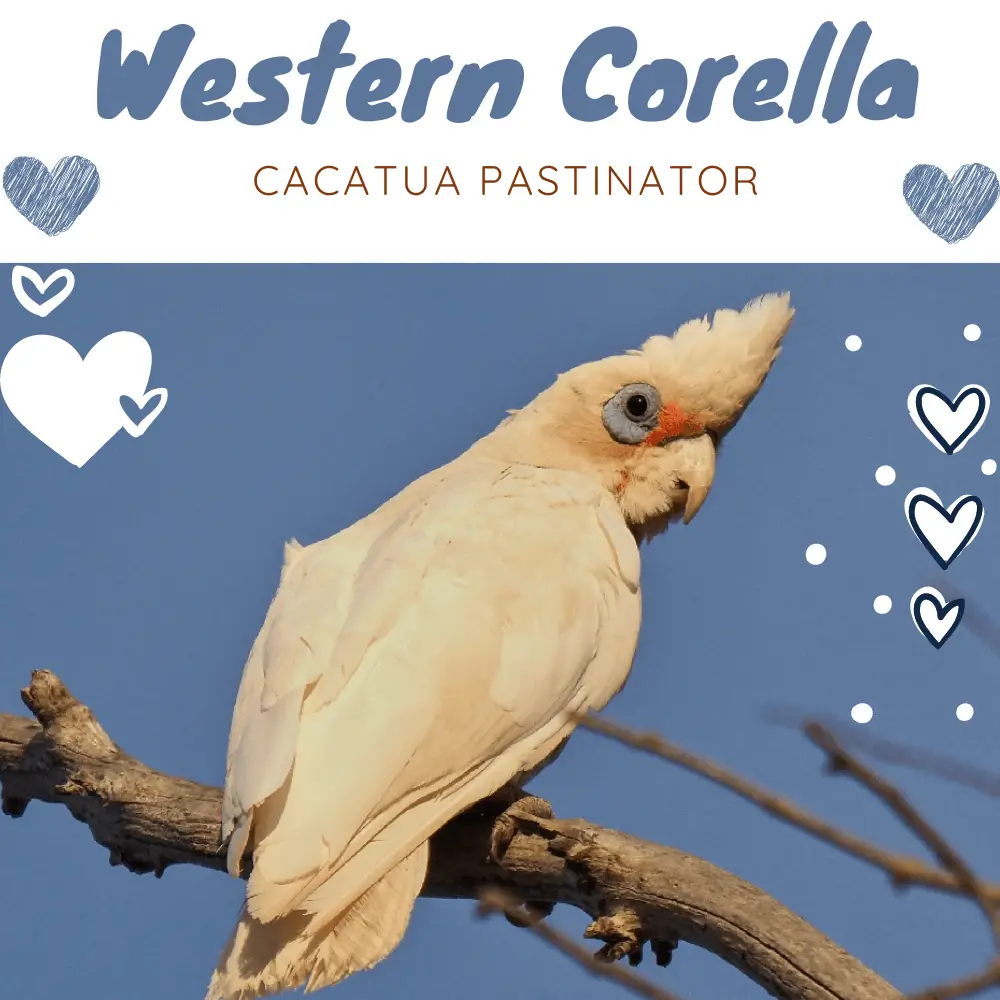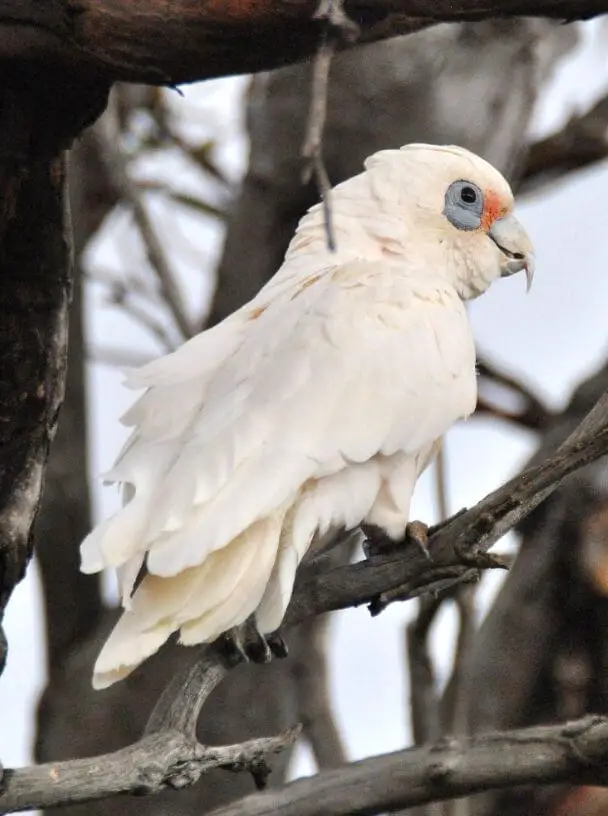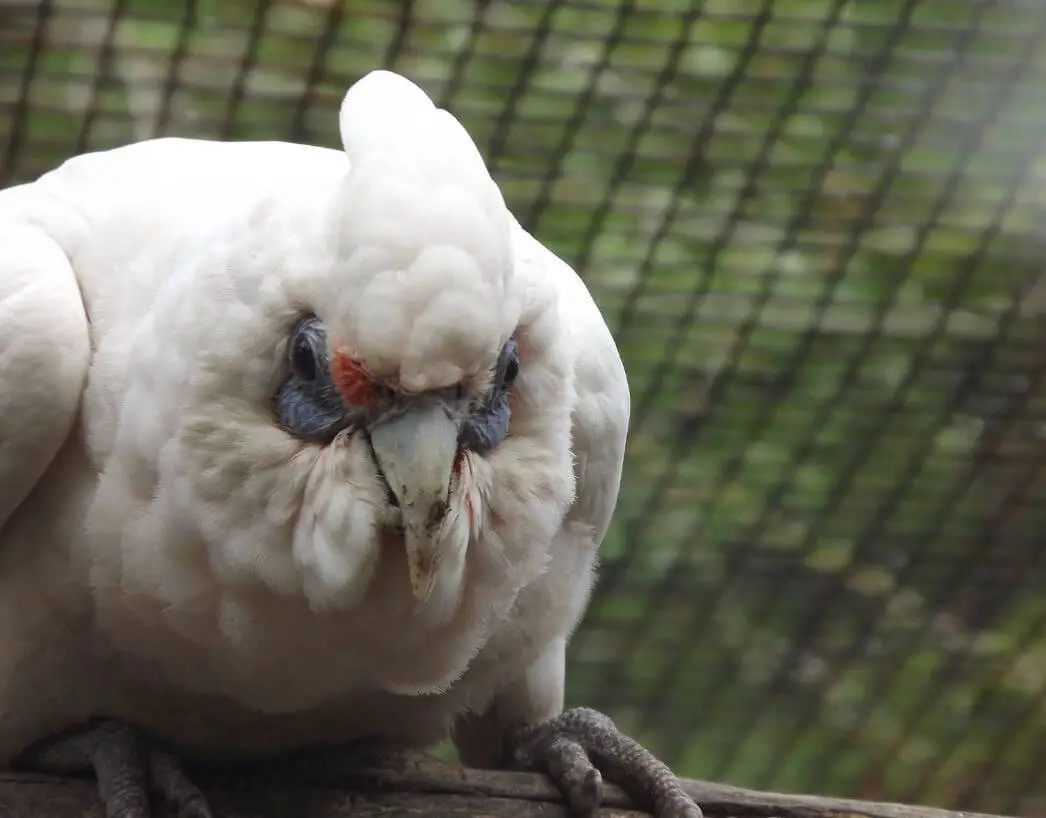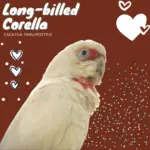
Western Corella (Cacatua pastinator) 37–45 cm; male c. 700 g, female c. 600 g. White, with medium-length crest (47–56 mm) and long upper mandible (37–52 mm);
concealed bases of the feathers of the head and neck salmon-red, showing as varying areas of red on face and forehead; underwing washed yellow; bare periophthalmic skin greyish blue; eye dark brown; bill horn-colored; legs grey.
Sexes alike. Separated from C. sanguinea on the generally larger size, with longer crest and longer bill; also on different calls.
Juvenile as an adult, but bill shorter and periophthalmic ring can appear greyer; reaches maturity only when 3–5 years old. Race derbyi averages shorter bill (42 mm in male, 37 mm in female) than nominate.
- LC Least Concern
- Names (14)
- Subspecies (2)
Systematics History
Editor’s Note: This article requires further editing work to merge existing content into the appropriate Subspecies sections. Please bear with us while this update takes place.
Sometimes considered to include smaller and smaller-billed C. sanguinea, and in the past treated as conspecific with C. tenuirostris; on current evidence, the three (entirely allopatric) forms probably best considered to constitute three separate species.
The type specimen of race derbyi was previously considered of doubtful origin and locality, but subsequently validated; described form butleri (from near Coorow) is a synonym of derbyi. Two subspecies were recognized.
Subspecies
SUBSPECIES
Cacatua pastinator derbyi Scientific name definitions
Distribution
N wheatbelt of W Western Australia, from around Geraldton S to c. 32º S.
SUBSPECIES
Cacatua pastinator pastinator Scientific name definitions
Distribution
SW Western Australia (centred around Unicup and L Muir).
Distribution
Editor’s Note: Additional distribution information for this taxon can be found in the ‘Subspecies’ article above. In the future, we will develop a range-wide distribution article.

Western Corella Cacatua pastinator
Habitat
Grassy, open forest and eucalypt woodland, especially along watercourses, and adjacent farmland with large trees; also recorded (more occasionally) from mulga and mallee.
Movement
Pairs tend to nest in traditional sites and to forage nearby (typically 1·6 km away) while breeding, until fledglings are large enough (when c. 2 weeks old) to accompany parents into the large nomadic foraging flock (typically 500–700 individuals in N population)
that forms throughout summer, autumn and early winter (Nov–Mar, sometimes only mid-Jan), when regularly forage up to 10 km from nest-tree and some N populations may regularly move 150–250 km north-west; such flocks may draw families from 50–100 km away.
Immatures leave the family group before next breeding season, to spend 3–5 years in a nomadic non-breeding flock, which moves over an area of up to 250 km², typically spending 1–2 weeks in a given area, before moving again, and which may range far from their natal areas.
Diet and Foraging

Western Corella Cacatua pastinator
Gregarious graminivore, but also takes insects and their larvae. The long upper mandible enables birds to dig up underground storage parts of a variety of native plants, e.g. Drosera, growing in woodland;
this food source became rare following European settlement and was replaced by cereal grains (particularly Avena sativa, Triticum aestivum, rice, and millet), native grasses (e.g. Poa annua), and exotic weeds, e.g. Emex australis (mainly in N of distribution) and Romulea rosea (especially in S of range); the latter has a bulb that corellas dig up when the soil is moist.
Western Corella also digs up germinating cereals and eat grain both from standing crops and from the ground. Sometimes forages in association with Eolophus roseicapilla, and regularly visits artificial waterholes to drink.
Sounds and Vocal Behavior
Considered to be very similar to that of C. sanguinea, giving a trisyllabic chuckling, various soft notes with a quavering quality, and a series of harsh shrieks in alarm.
Breeding
Laying Jul–Oct. Pair-bond maintained throughout the year. Nest is a bed of woodchips, in a tree hollow in native eucalypts, mainly Eucalyptus salmonophloia in N and E. calophylla in S, and typically in mature to dying trees with a very open canopy.
Usually, 2–3 eggs (range 1–4, mean 2·7 in one study); incubation 22–26 days by both parents, and both feed the nestlings; hatching asynchronous, and brood reduction by the death of smallest nestling occurs frequently in the first two weeks of nestling life;
chick has sparse pale yellow down; young parrots leave the nest when c. 60 days old (52–68), and stay in contact with parents until at least autumn (Apr-May) of their first year, i.e. almost to start off following nesting season.
On average over several years, pairs raised 0·8 nestlings to independence each year, with hatching success and fertility rates of 67% and 77%, respectively, 8% of clutches failing completely, and overall productivity of 58% from the egg stage, rising to 84% from those eggs that hatched.
Conservation Status

Conservation status on BirdlifeLC Least Concern
Not globally threatened. CITES II. Previously considered Near Threatened. The population of nominate pastinator may be increasing, but at present numbers c. 1000–1500 birds (was considered almost extinct in the early 1940s), and race is classified as Endangered; this is especially pertinent as most members of the population gather to feed on localized oat crops in just five or six areas.
Race derbyi appears to have survived a long period (1860–1960) of harassment from farmers, who poisoned them, and shot them as agricultural pests;
this population is now thriving and expanding, due to both to protective legislation (although a few are still shot pr poisoned illegally) and expansion of agriculture since the 1950s.
Dependence on old to very old trees for nesting may limit species’ breeding capacity in near future, although the extent to which current forest practices amplify this problem (and the age of the trees that C. pastinator requires for nesting) have been strongly disputed.
Western Long-billed Corella (Cacatua p.pastinator) priam.com.au
SOURCE: PriamAustralia




















